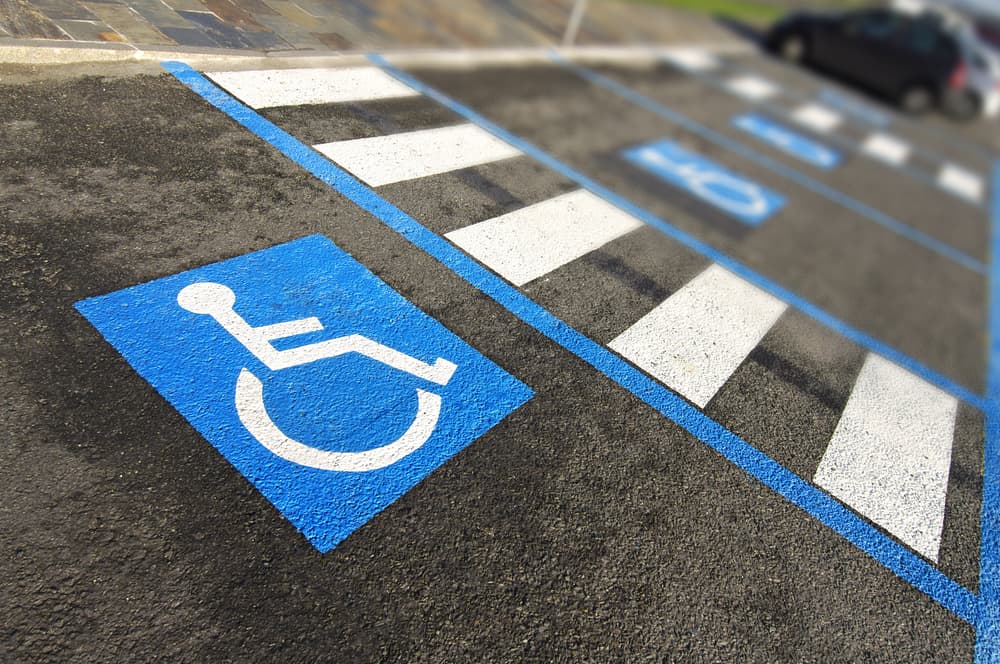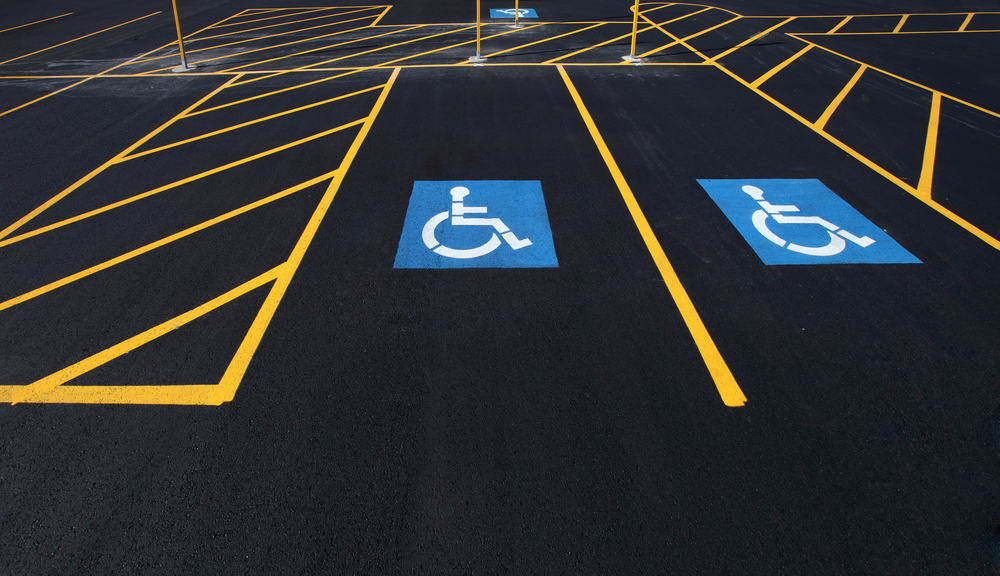Best Practices for Meeting ADA Guidelines in Handicap Parking Lots

Many people with disabilities rely on handicap parking spaces to go about their daily lives. To ensure that these spaces are available when and where needed, meeting ADA guidelines for handicap parking lots is essential.
Understanding the standard rules and regulations for designating and maintaining handicap-accessible parking spaces is essential.
It doesn’t matter whether you’re a contractor, property manager, or owner; doing so has numerous benefits for handicapped community members. It also protects you from getting sanctioned due to non-compliance.
Let’s explore the best practices for designing and constructing ADA-compliant parking lots and how to follow the standards set by the ADA’s governing laws. From design guidelines to maintenance requirements, this is a comprehensive guide to comply with and exceed ADA regulations.
ADA-Compliant Parking Lots: What You Need to Know
ADA-compliant parking lots are a vital part of making sure that people with disabilities can easily access the places they need to go. Properly equipped and maintained accessible parking spaces are necessary to ensure safety and convenience for those who need them.
Having an ADA-compliant facility goes beyond painting the universal symbol of accessibility on or near parking spaces, although it’s a significant first step.
Full compliance with the ADA rules and regulations for handicap parking requirements needs you to consider and maintain proper space locations, markings, and stall sizes.
The 2010 ADA Standards for Accessible Design include the minimum provisions and handicap parking space requirements. Non-compliant installations and facilities can attract expensive fines or form grounds for a civil lawsuit.
To meet ADA regulations, a parking lot must have the following:
Clearly marked spaces for vehicles with designated handicap plates or placards
Van accessible spaces
Appropriate signage for each spot
Unobstructed curb cuts at entrances and exits
Proper surface materials and slopes
Adequate lighting and striping
Additionally, it’s important to remember that all elements of the lot should have regular inspection and maintenance according to ADA standards to remain compliant. With our expertise and experience, you can count on a safe environment that is welcoming and accessible for everyone who needs it.

The ADA Standards for Access Aisles
The Americans with Disabilities Act (ADA) has pre-established standards for access aisles to ensure that people with disabilities can safely navigate parking lots with the allowed parking spaces provided.
Access aisles are areas adjacent to handicap parking spaces that allow enough room for wheelchairs, walkers, and other devices to enter or exit vehicles easily.
To meet ADA regulations, these aisles must be level and at least 60 inches wide.
They must have striped borders on both sides of the aisle
They must have clear markings as “no parking” zones, so drivers do not block them when accessing their vehicles (this includes parking garages)
Adhering to ADA guidelines will help create an accessible environment where people with disabilities can move freely and safely. At CATI Striping & Coating, we specialize in parking lot striping, so we understand these guidelines inside out. You don’t have to worry about memorizing, researching, striping, or maintaining your parking lots.
ADA Parking Striping Requirements for Handicap Parking Spaces
ADA parking striping requirements are essential for accessible parking for individuals with disabilities.
Striping helps to:
Clearly define the spaces
Create a safe environment
Ensure compliance with ADA regulations
The stripes must be at least 4 inches wide and have a contrasting color compared to the pavement or surface material around them.
Additionally, they should be in a way that maximizes the visibility of each handicap space from all angles. They also ensure enough room for wheelchair users to maneuver between parked cars.
Lastly, it’s essential to make sure that any access aisle leading into or out of the designated handicap spots has its own set of stripes so people know not to park on it.
Following these simple guidelines will help ensure your parking lot meets all ADA parking requirements and provides those with disabilities easy access when they need it for all parking facilities and parking garages.
Are Accessible Spaces Necessary?
Yes, accessible parking spaces (and accessible entrances) are a requirement by the Americans with Disabilities Act (ADA).
Accessible parking is essential to creating safe environments for people with disabilities. These spots provide easy access to businesses, stores, medical facilities, etc. They also help ensure compliance with federal regulations set out by the Americans with Disabilities Act.
It’s important not just to comply but exceed these regulations so that everyone has equal access, no matter their physical abilities.
You should also schedule regular inspections and maintenance with us for all elements of the lot according to ADA standards. All this will go a long way toward improving accessibility.
The Location of Accessible Parking Spaces
Accessible parking spaces are available in many places, from businesses and stores to medical facilities.
These spots must be clear, with appropriate signage for each area. This includes ADA-compliant striping around the edges of the space.
These spaces should also be near entrances or exits so that wheelchair users can easily access them without having to maneuver around obstacles like parked cars or curbs. All accessible entrances need to be marked to show the accessible route that is needed to be taken.
Additionally, accessible parking spaces should have adequate lighting and unobstructed curb cuts at both ends. It makes it easier for those who need it to safely get in and out of their vehicles.
With these considerations in mind, accessible parking is sure to provide an easy way for people with disabilities to enter and exit any building or facility.
When creating accessible parking spaces, there are a few things you’ll want to keep an eye out for. First, it’s essential to maintain designated handicap plates or placards and appropriately sized van-accessible spots with ramps where necessary.
Additionally, you’ll want to ensure that all elements of the lot meet ADA standards.
We are ready to help you fulfill this checklist to ensure your facility has safe and convenient accessible parking options.
Increasing the availability of accessible parking spaces can encourage more people with disabilities to participate in daily activities.
Features of an Accessible Parking Space
Accessible parking spaces are vital to ensuring everyone can get around safely and easily.
These spots have a design with several features in mind, such as:
Designated handicap plates or placards
Van-accessible spaces with ramps, if necessary
Appropriate signage for each spot (including striping at least 4 inches wide in contrasting colors next to curb cuts leading into the space)
Adequate lighting
Unobstructed curb cuts at entrances and exits
Proper surface materials and slopes
Regular inspection/maintenance according to ADA standards
All these features work together to create a safe environment for those who need it, so they can enter any building or facility without worry. Another feature of accessible parking spaces is that they must have clear specific signs indicating their purpose.
This allows anyone looking for them—whether they have a disability or not—to know where they are. Additionally, good accessibility also means leaving enough room between parked cars so wheelchair users can maneuver through the lot easily.
With all these considerations taken care of, you can rest assured that your accessible parking area meets both safety requirements and federal regulations set out by the Americans with Disabilities Act.
ADA Handicap Parking Sign Requirements
Accessible parking spaces must have clear markings and a pole with the International Symbol of Accessibility mounted.
The universal symbol has a white rendering and portrays a person in a wheelchair on a blue background.
These symbols should be a minimum of 5 feet (60 inches) off the parking surface or ground. This height prevents the signs from getting obstructed even if there’s a vehicle in front of it.
The pole with the accessibility symbol should be at the head of the parking area without obstructing the cars parking in the stall. Anyone should be able to see the sign from the driver’s side.
For van-accessible parking spaces, the handicap-access sign should have some corresponding text.
Car and Van-Accessible Parking Spaces
Car and van-accessible parking spaces help to provide safe and convenient access for all drivers.
These spots typically have wider handicap parking space dimensions and special striping on the pavement. They require a valid disabled placard or license plate to use them.
Car-accessible parking spaces are also close to entrances and exits so wheelchair users can easily get in and out of their vehicles.
Accessible Parking Pavement Painting and Space Size Specifications
When it comes to accessible parking spaces, size really does matter. The standard handicap parking dimensions for an accessible area are 8 feet wide by at least 18 feet long.
The space should have clear markings, with two painted lines that are no less than 4 inches in width. Not only does this space give wheelchair users a safe maneuvering area, but it also allows enough room for ramps if necessary.
Additionally, it’s important to note that you should resurface the entire lot every 5-7 years according to ADA standards. Resurfacing ensures that all markings remain visible and in good condition over time.
At CATI Striping, we use the highest quality paint and modern machinery to ensure maximum visibility.
Handicap parking space painting requirements are also incredibly important when creating an accessible parking space. The two stripes that mark each spot must contrast against the pavement material—so think bright yellow or white against black asphalt.
They must be at least 4 inches wide with a maximum of 6 inches between them. Lastly, these stripes have to extend from the entrance or exit leading up into the stall itself without any breaks or interruptions along their length.
This continuity ensures wheelchair users can safely navigate through the lot without worry. Once you follow these guidelines, you can rest assured that your accessible parking areas meet all required federal regulations outlined by the ADA.
The Unique Width Requirements for Access Aisles and Accessible Parking Spaces in the US
When it comes to accessible parking, the width of spaces and access aisles is a crucial factors that you must adhere to. According to ADA handicap parking requirements, all accessible parking spots should have a minimum width of 8 feet – with two painted lines no less than 4 inches in width for visual guidance.
Alongside this, there must also be an adjacent access aisle at least 60 inches wide. It allows wheelchair users to maneuver around their vehicle as necessary safely. This ensures that individuals with disabilities can park their cars without issue while still having enough room to move around comfortably.
It’s essential for facilities or businesses providing accessible parking areas to adhere strictly to these guidelines. It’s the only way to ensure everyone has equal access and convenience when visiting the premises.
Accessible Parking in Hospital Outpatient Facilities
Accessible parking in hospital outpatient facilities is essential to providing quality care to individuals with disabilities.
All hospitals must follow the Americans with Disabilities Act (ADA) regulations. When it comes to maintaining these areas, regular inspections should be routine to ensure all elements meet ADA standards.
Beyond this, it’s also important for hospital staff or volunteers to regularly inspect other key items such as striping, lighting, curbside accesses, etc.
By following these simple steps, you can help guarantee your hospital’s accessible parking area meets all required federal regulations set out by the ADA – creating a safe and convenient experience for everyone who visits.

How Many Handicap-accessible Stalls Does the ADA Require in a Facility?
The number of handicap-accessible stalls required in a facility by the Americans with Disabilities Act (ADA) depends on the total number of parking spaces available.
According to ADA guidelines, at least one accessible parking spot must be available for every 25 overall stalls – with all accessible spaces being on the same level.
For instance, if your facility has 100 parking spaces, you must have at least four spots designated for people with disabilities. Additionally, if there are more than 500 total stalls, then at least 20 percent of all spaces must be accessible – whichever is greater.
These regulations allow wheelchair users the same convenience and access available to those who don’t need special accommodations.
However, there are several exceptions you should note:
Parking lots designated exclusively for vehicle impound lots, law enforcement vehicles, delivery vehicles, trucks, and buses don’t need handicap-accessible spaces. However, if the facility has public access, a handicap-accessible zone must be available for persons with disability.
Clinics or rehabilitation centers that offer therapy or treatment to physical therapy or mobility-impaired patients need an extra 20% more than the regular accessible parking space requirement.
Medical facilities, like outpatient facilities and hospitals that offer outpatient services, must have 10% more designated parking spaces for visitors and patients.
How to Mark or Identify Accessible Parking Spaces
It’s essential to clearly mark and identify accessible parking spaces to ensure everyone is aware of their existence. Ensure you observe ADA parking signs requirements, including:
Labeling the space with signs
Striping the edges with contrasting colors compared to the pavement material
Painting two lines that are no less than four inches in width
The minimum size requirement for regular accessible parking spaces should be at least 8 feet (96 inches) wide. The measurements should apply to the spot’s entire length.
You should have a 5-foot (60-inch) access aisle adjacent to the designated parking space. It should guide a person to an accessible entryway or access ramp.
The aisle’s goal is to provide room to easily handle and operate mobility aids such as walkers and wheelchairs. Two accessible parking areas can share one access aisle.
Van-accessible parking spaces should be 11 feet (132 inches) wide for the parking stall’s entire length. However, in some cases, you can narrow the parking space to 8 feet (96 inches), provided the adjacent access aisle is the same width.
You should have the access aisle on the van’s passenger side since most people typically deploy wheelchairs and lifts from that side.
Furthermore, the vertical clearance for the adjacent access aisle and van-accessible parking spots should be at least 8.17 feet (98 inches). These ADA parking space requirements ensure that the parking space can accommodate the standard height of lift-equipped vehicles.
The most popular colors that paint handicap-accessible spaces are white and blue. However, you can also use green, yellow or red, as long as the pavement markings contrast with the pavement surface’s color.
It would be best to paint the access aisles using white diagonal hatch marks to prevent non-disabled people from parking. You can also accompany the pavement marking with the words “No Parking.”
Additionally, having adequate lighting and unobstructed curb cuts at entrances/exits will help provide easy access. It also helps wheelchair users safely navigate through the lot.
It’s important for facilities or businesses providing accessible parking areas to adhere strictly to these guidelines, so everyone has equal access when visiting.
You should plan for regular inspections on a routine basis to ensure all elements meet ADA standards. All these steps combined can guarantee your facility meets all required federal regulations set out by ADA– creating an inclusive experience for everyone who visits.
Other Requirements and Governing Laws for Accessible Parking
When it comes to accessible parking, there are specific governing laws, and other ADA parking requirements that we have to adhere to for a space to comply with the Americans with Disabilities Act (ADA).
These handicap parking space requirements include:
Adequate signage indicating specific spots designated as accessible
Proper striping along the edge of each space with contrasting colors compared to pavement material
Unobstructed curb cuts at entrance/exits
Adequate lighting
Additionally, all spaces should be 8 feet wide by at least 18 feet long. Have the spaces clearly marked with two painted lines at least 4 inches in width. This ensures wheelchair users can safely navigate through the lot without worry.
The ADA established these specifications to ensure facilities and establishments maintain accessible parking for people with disabilities.
Besides these general regulations and rules, various local governments and states have individual requirements. These requirements are often stricter and more specific. It’s best to confirm the handicap-accessible requirements in your locality, city, or state to ensure compliance before you stripe your parking facility.
Our experts have the right knowledge, skills, and experience across the US to understand these guidelines. Call us immediately to avoid non-compliance fines of between $1500 and $10,000 or more.
Beyond these governing laws, regular maintenance is also essential for an accessible parking area. You should promptly repair any potholes or cracks on and near the area.
Ensure you also clear various forms of obstruction, including:
Mud
Ice
Loose pebbles
Fallen leaves
Debris
Accessible spaces should remain obstruction-free at all times. Resurfacing every 5-7 years will ensure all markings stay visible and in good condition over time.
It’s also important to regularly inspect areas such as striping, lighting, curbside accesses, etc.
Any necessary repairs or replacements can take place before they become a bigger issue down the road. Taking steps like these help guarantee your accessible parking area meets all required federal regulations set out by the ADA – which ultimately leads to increased safety and convenience for those who use them.
Prioritize Compliance
Accessible parking is integral to accommodating the needs of people who rely on wheelchairs and other mobility aids. As such, it’s essential to understand the guidelines you must follow when designing ADA-compliant parking lots. For instance, you should know what features are necessary and how you should lay them out.
When providing accessible parking areas, following the guidelines set by the Americans with Disabilities Act (ADA) is essential. By ensuring all spaces are 8 feet wide, have two painted lines no less than 4 inches in width and have an adjacent access aisle at least 60 inches wide, you can help guarantee everyone has equal access when visiting your facility. All businesses should make sure they provide accessibility to their customers by providing ample, easily identifiable accessible parking spaces.
Additionally, schedule regular inspections to ensure everything remains up to par – from striping and lighting to curb cuts and more. Resurfacing every 5-7 years will also help maintain good visibility of markings over time.
While specific guidelines may exist for each type of facility or situation, all parking spaces should adhere to basic ADA standards for access aisles and striping and painting requirements. With proper planning, you can ensure your business or facility is ADA compliant – and make sure that everyone has equal access.
Luckily, our experts understand these detailed guidelines, so you don’t have to worry about a checklist. Request a free quote today and ensure your facility remains compliant as you focus on more vital aspects of your business.

